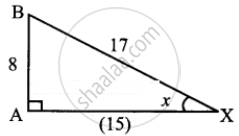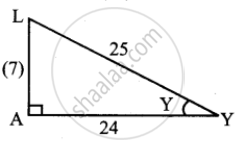Advertisements
Advertisements
प्रश्न
Find sin(x – y), given that sin x = `8/17` with 0 < x < `pi/2`, and cos y = `- 24/25`, x < y < `(3pi)/2`
उत्तर

sin x = `8/17`, 0 < x < `pi/2`
⇒ Where x is in I quadrant
∴ sin x, cos x are +ve
From ΔABX,
AX = `sqrt(17^2 - 8^2)`
= `sqrt((17 + 8)(17 - 8))`
= `sqrt((25)(9))`
= 5 × 3
= 15
∴ sin x = `8/17` and cos x = `15/17`
cos y = `- 24/25, pi < y < (3pi)/2`
⇒ Where y is in III quadrant
So, sin y and cos y are –ve
From ΔALY,
AL = `sqrt(25^2 - 24^2)`
= `sqrt(49)`
= 7
∴ cos y = `- 24/25` and sin y = `- 7/25`
sin(x – y) = sin x cos y – cos x sin y
= `(8/17)(- 24/25) - (15/17)(- 7/25)`
= `- 192/425 + 105/425`
= `- 87/425`
APPEARS IN
संबंधित प्रश्न
If sin x = `15/17` and cos y = `12/13, 0 < x < pi/2, 0 < y < pi/2`, find the value of cos(x − y)
If sin x = `15/17` and cos y = `12/13, 0 < x < pi/2, 0 < y < pi/2`, find the value of tan(x + y)
Prove that cos(π + θ) = − cos θ
Expand cos(A + B + C). Hence prove that cos A cos B cos C = sin A sin B cos C + sin B sin C cos A + sin C sin A cos B, if A + B + C = `pi/2`
Show that tan 75° + cot 75° = 4
If x cos θ = `y cos (theta + (2pi)/3) = z cos (theta + (4pi)/3)`. find the value of xy + yz + zx
Show that tan(45° − A) = `(1 - tan "A")/(1 + tan "A")`
Find the value of tan(α + β), given that cot α = `1/2`, α ∈ `(pi, (3pi)/2)` and sec β = `- 5/3` β ∈ `(pi/2, pi)`
If θ + Φ = α and tan θ = k tan Φ, then prove that sin(θ – Φ) = `("k" - 1)/("k" + 1)` sin α
If θ is an acute angle, then find `cos (pi/4 + theta/2)`, when sin θ = `8/9`
If cos θ = `1/2 ("a" + 1/"a")`, show that cos 3θ = `1/2 ("a"^3 + 1/"a"^3)`
Show that `cot(7 1^circ/2) = sqrt(2) + sqrt(3) + sqrt(4) + sqrt(6)`
Prove that (1 + sec 2θ)(1 + sec 4θ) ... (1 + sec 2nθ) = tan 2nθ
Show that sin 12° sin 48° sin 54° = `1/8`
Show that cot(A + 15°) – tan(A – 15°) = `(4cos2"A")/(1 + 2 sin2"A")`
If A + B + C = 180°, prove that sin A + sin B + sin C = `4 cos "A"/2 cos "B"/2 cos "C"/2`
If A + B + C = 2s, then prove that sin(s – A) sin(s – B)+ sin s sin(s – C) = sin A sin B
Choose the correct alternative:
cos 1° + cos 2° + cos 3° + ... + cos 179° =
